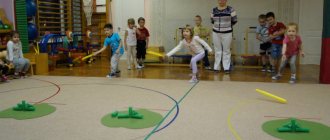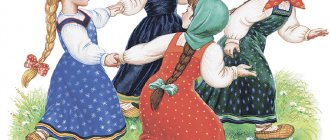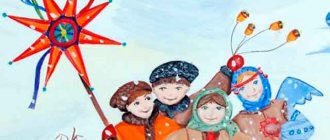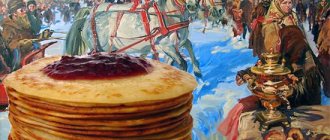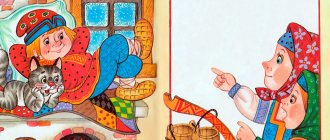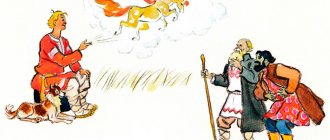The Great Veles Christmastide began after the winter Solstice and continued until Vodokres. Our ancestors believed that at this time the line between the worlds becomes very fragile, and by performing certain rituals, we can ask the Grandfathers and Gods for help.
That is why Russian folk games and fun in winter were supplemented with special ritual games. They were called upon to appease powerful helpers and protect people from evil forces.
Folk games and fun of mummers carried a deep meaning
Modern masquerade costumes, which children and adults dress up for the New Year, are a tribute to ancient Slavic customs. Only then did the mummers take their attire much more seriously and attach deep meaning to it.
Frightening masks, faces smeared with soot, clothes turned inside out, and the strange behavior of the mummers were intended to quickly send the old year into the past, to make way for the birth of a new Sun.
Everyone, young and old, took part in the ceremony. Children in masks rushed around the villages during the day, young people had fun in the evenings, the most difficult burden fell on the adult mummers at night.
Ritual Russian folk games and entertainment were accompanied by the singing of carols and dancing. At this time, it was not forbidden to perform full-fledged performances and simply be mischievous.
LiveInternetLiveInternet
A striking feature of the culture of every nation is the games it creates.
For centuries, these games have accompanied the everyday life of children and adults,
develop special mentality traits, important personal qualities, reflect the social structure of the nation and views on the world. Slavic folk games represent a conscious initiative activity,
aimed at achieving a certain goal established by the rules of the game,
which is formed on the basis of Slavic national traditions and takes into account cultural,
social and spiritual values of the people. They combined entertainment, training, and the unique Russian culture itself.
identifying and encouraging those who are strong in spirit and body, fostering readiness to take on challenges,
stand up for the weak, overcome weakness in yourself. Quote: “Games have long served as a means of self-knowledge, here they showed their best qualities: kindness,
nobility, mutual assistance, self-sacrifice for the sake of others.
After a hard day of work, adults enjoyed taking part in children's games,
teaching them how to have fun and relax.”
A.A.
Taran, “Russian folk games and their classification” What is it?
In this article we will look at the main types of such games - from simple entertainment for common people,
to royal amusements, from forgotten amusements to disciplines that have become sports today
and crossed the borders of Russia, Ukraine and Belarus. Antiquity was not particularly rich in entertainment, but it was truly massive -
everyone, young and old, took part in the festivities and celebrations.
On the holiday, a rare day free from work, people sought to take a break from hard everyday work by playing,
competing or simply participating in the fun as spectators. But games served our ancestors not only as fun and entertainment,
and also military training before battles with opponents, of which the Slavs always had a great variety. The very word “fun” among the Slavs did not have a completely “entertaining” meaning, but a broader one: “mass event”.
Most often, the mass event was one of the games listed here.
A duel between two Slavs. You definitely need to fight.
Martial arts
Fist fight. Throughout History, the Slavs waged constant wars, and military exercises and games
became an integral part of ancient Slavic culture, firmly entering everyday life and being reflected in traditional “fun”.
Russian fist fighting (“fist fun”) is a vivid example of this.
Historical reference
The first chronicle mentions of fist fighting are found at the beginning of the 13th century. Grand Duke of Kiev, Mstislav III,
and the Prince of Pskov, Vladimir, encouraging his soldiers before the battle, presented them with freedom: to fight on horseback or on foot.
And I received the answer: “We don’t want to go on horseback, but we will fight, following the example of our ancestors, on foot and with fists.”
At first glance, fist fighting may seem like a rather barbaric form of entertainment.
But, remembering that in Rus' there was rarely a year without war, it is quite natural that for the common people
(which at any moment could be called upon as a militia) it became a historical tradition.
And for the state as a whole - a useful school in which the population learned the art of war “on the job.”
Usually poorly armed militias sought to compensate for this disadvantage with quick reaction and skillful,
unexpected use of the situation, and this is what fistfight taught them. Fist fights were carried out one on one or “wall to wall” (group fight).
Fist fights have always attracted many spectators, hungry for the spectacle of uncompromising struggle
One-on-one fights (“sam-vs-sam”) were mainly carried out before mass battles, or were used to resolve disputes,
as well as in judicial practice. In the latter case, such a duel was called “field”
and was used as judicial evidence: it served to definitively confirm the defendant’s correctness in a court case. The most outstanding single fighters were willingly taken by the boyars “under their wing” -
they fed from the master's table and were showered with all sorts of favors, and the boyars bet on them, bringing them together in fights for their amusement. “Wide” places were chosen as places for battles in the summer - city squares, clearings.
In winter, “fun” most often took place on the ice of rivers or lakes. The battles took place during Russian folk holidays,
most of which in Rus' are carried out for the winter. They went out to fights in felt boots and short fur coats,
which left a certain imprint on the fighting technique.
The blows were applied in such a way as to pierce warm clothing - using the weight of the entire body.
“Fists” of all ages and classes gathered on the ice of a frozen river
Most fist fights were “proper”, i.e. carried out according to the rules.
Here are their main provisions:
· fight “for love” - that is, have no anger towards the enemy,
· do not hit a lying opponent,
· do not hit from behind,
· do not hold heavy objects in your fist,
· do not trip or grab the opponent’s clothes,
· do not kick (a kick with a shod foot could cripple the opponent).
Almost the entire male population, from boys (!) to adults, took part in wall-to-wall battles.
The teenagers “started” the fight, then the men came together, and at the end the strongest “reliable” fighters joined in.
Each wall could have two, three, four or more rows of fighters. They fought street to street, village to village, settlement to settlement. Group combat taught me to stand shoulder to shoulder, allowing me to practice joint actions.
A sense of comradeship and mutual assistance developed - skills that are indispensable in battle.
The fist fight continued until one of the parties fled. At the end of the “fun”, the most distinguished fighters were honored -
They were given wine to drink and led through the streets with songs glorifying their exploits. However, no uniform rules were used and often the battles were limited to
only unchanged - “don’t beat someone who is lying down” and “don’t kill them to death.” There was also a very tough type of battle, “dump-clutch”, more reminiscent of a massacre -
it used everything from kicks to flails, sticks and knives. After such dumps, people were often left injured and even killed.
Before the battle, obligatory cleansing rituals were carried out
From the fact that even children were allowed to engage in fist fights, it is clear that
which the Slavs had to cultivate the strength of body and spirit from childhood. It’s wild for a modern person to imagine
how a mother would let her child go into a 50/50 fight, senseless and yet quite brutal. However, for our ancestors this was a completely meaningful and acceptable lesson,
a kind of school for men, as concrete as possible, “on living material”, teaching not just fighting skills and tricks -
but much more important is the spirit of joint competition, mutual support and unity. Hardened from childhood for life. Looking back at the traditions of Russian fist fighting, it becomes easier to understand that unprecedented resilience
and the self-sacrifice that the Slavs from time immemorial have shown in wars for their homeland.
With the development of firearms, fistfights lost their practical significance for the state
(Christianity played a significant role here, striving to eradicate pagan customs) and it declared them “harmful fun.”
In 1274, Metropolitan Kirill convened a council in Vladimir, at which, among other rules, it was decided:
“excommunicate from the church those involved in fist fights and stake fights, and do not perform funeral services for those killed.” Fist fights were prohibited with enviable consistency, but even after the decree of Nicholas I (in 1832)
“On the universal and complete prohibition of fist fights” (“Fist fights, as harmful fun, are completely prohibited”) -
they did not cease to exist and continued to be preserved in folk life:
“In Moscow there was a factory worker named Semyon, a strong fighter who knocked a tile out of the oven with his iron hand, and when he appeared in front of the wall in battle he knocked everything over and drove it in front of him. Fear, horror before him, And cries of joy and praise follow him...” A.E. Izmailov
The outcome of this fight is familiar to us from school. “Song about the merchant Kalashnikov” by M.Yu. Lermontov, illustrated by Vasnetsov
Historical reference
After 1917, fist fighting was included in the “rotten legacy of the damned tsarism”
and did not find its place among wrestling sports. The ideology of fist fighting, based on religiosity and community cohesion,
went against the party ideology, which extols completely different values, and fist fighting did not receive any development during the years of Soviet Power.
All attempts to introduce folk fighting techniques into the training program for border guards and police were unsuccessful. The revival of fist fighting is already happening in our time - numerous schools and styles of Slavic martial arts are appearing,
based on the traditions of fist fighting or using its elements.
Professional communities of Slavic martial arts:
Dances and dances
It is now difficult for us to discern and understand the roots of modern Slavic dance when watching it on TV
or at festivities and holidays performed by folklore groups. And it was not created as entertainment at all,
but as a specific system of game training for Slavic warriors, helping to develop
combat motor skills, endurance develop agility and strength. Gopak, trepak, “Cossack”, “lady”, sailor’s “apple” and other dances contain residual elements of foot combat and martial arts.
Cossacks are big fans of dancing the hopak. And there are still legends about how they fought in other countries
For example, the essence of the most famous Russian dance “Barynya” was not just to dance with a woman.
It’s about fighting for a partner with other dancers, and fighting not with force, not with rudeness, but with dancing skill! They danced with the woman, trying not to let their rival get close to her.
He, in turn, tried to fight off the dancer, brushing off his opponent with a skillful movement and continuing the dance himself.
Therefore, the real “Lady” is very difficult - careful control over complex combat transitions is required.
It was considered unacceptable not only to touch a partner with a blow, but even to frighten her with a dangerous movement.
It turns out that it’s not a dance, but a duel – but not a fight, but an art!
Since ancient times, dancing competitions have been held in Rus'. They danced both alone and in pairs with an opponent.
The competition most often took place at fairs. They “bet” on the dancers and placed bets, and the winners received prizes: gifts, money or wine. The dancers constantly trained, inventing new combinations of “knocks” unknown to their opponents and spectators.
Before the competition, the developments were kept a big secret. This constantly replenished and enriched the technique of Russian dance.
“Lady” is only a peaceful dance at first glance. The struggle for a girl is relevant between young people at all times. It was this confrontation that formed the basis of the dance
There were pair and single dances. In the first case, one of the dancers showed some kind of movement or connection,
the opponent had to repeat them exactly, then show his own. In the second, the competitors alternately showed their movements,
however, the previous ones could not be repeated. The loser was the one who ran out of tricks first. Historical reference
One of the variants of the combat dance “skobar” (or, as it was also called, “breaking the merry”)
provided for direct contact with the enemy during execution.
They “performed” it to the rhythmic and simple playing of an accordion. The fight-dance took place according to various agreements, for example, until the first blood or until the first fall.
The fight could be stopped by an accordion player (in older times - a guslar) by stopping playing. Before the “breaking” began, the dancer shook his head, ruffling his hair.
These actions, coupled with certain exclamations and stamping, belonged to the elements of ancient folk magic.
By performing them, a person left the usual everyday space, moving into a different layer of existence,
where time flowed differently and the senses worked differently. The relaxed body of the squire reacted not only to the actions of his opponent, but even to the breath of the breeze.
This state is similar to the trance into which the warriors of the East put themselves.
In addition to military dances, there were also numerous peaceful dances and games,
ritual and simply entertainment purposes. The most “Slavic” of which is the round dance (kolo, korogod, tank).
Games-rites
Ritual games in Rus' are somewhat akin to modern role-playing games.
The players dressed up (“dressed up”) in various clothes - taking on the images of animals or higher powers. Such games were based on the natural magic of similarity: pancake, round dance, burning wheel -
are like the sun and, remembering him, people make his images, asking him to return as soon as possible after the winter cold.
They believed that they were really helping spring come faster. Christianity was never able to completely eradicate the belief in pagan gods,
and parts of ancient rituals, no, no, yes slip through in our everyday life.
Rus' did not immediately accept the new faith. Clashes between pagans and Christians shook the country for a long time
Round dances throughout Rus' were used as a festive ritual dance, mainly in the spring.
The circle among the Slavs was a symbol of the sun, and the dance symbolized the approaching blossoming of nature
and sought to help her awaken after winter. The round dance was accompanied by a song asking for the future harvest.
People brought a large loaf of bread baked the day before to the field and “fed” the earth with it. They also used dance to ward off supposed trouble from the village -
one peasant on a horse plowed the land along the edge of the entire village, and the rest, holding hands, followed him in a chain and sang.
Round dances are a favorite pastime of rural youth. You can choose the bride and look after the groom
The round dance also served as youth entertainment and included not only the circular dance itself,
but also much more: walkers played musical instruments, everyday scenes and pantomimes were played out within the round dance itself.
Komoeditsy (March 23) - “holiday of eating koms,” special pancakes dedicated to the bear. Better known as Maslenitsa. People jumped over fires, washed themselves with melt water or snow,
after which they solemnly burned the effigy of Winter Madder at the stake, throwing garbage, straw and old things into the fire.
Historical reference
Usually Maslenitsa (Madder) was represented in the form of a huge effeminate figure made from straw,
they dressed him up in an absurd way, put him in a sleigh and drove him around the villages.
The carnival train could consist of a dozen sleighs in which mummers rode around.
After the completion of the festive ritual, the doll was burned, saying goodbye to it: “Farewell, farewell, Our Maslenitsa. Farewell, farewell, Our broad..." The image of Maslenitsa combined the deadly (winter) and life-giving (spring) principles:
people seemed to be entering a new life and saying goodbye to the old one. With the adoption of Christianity, the image of Maslenitsa underwent significant changes,
although he did not completely lose his pagan features.
Nothing can replace the living spirit of the holiday. Not many people in our time have managed to ride a troika like that while playing an accordion.
After this they went to “wake up the bear” (“wake up”). In a pit-den, covered with dead wood, lay a mummer,
depicting a sleeping bear. They danced around the den, shouting and trying to wake up the clubfoot.
Then they started throwing branches, snowballs, and twigs at him. “The Bear” didn’t wake up until
until one of the girls sat on his back and bounced on it.
Then the girl ran away, taking with her a piece of the bear's outfit.
The mummer got up and began to dance, imitating the awakening of the bear, and went to look for his loss, leaning on a crutch:
“Creak your leg, creak your linden leg! And the water is sleeping, and the earth is sleeping. And they sleep in the villages, they sleep in the villages. One woman does not sleep, she sits on my skin. He spins my fur, cooks my meat. It’s drying out my skin.” Having caught his offender, the “bear” tried to “strangle” her in his arms. After the “awakenings” it was the turn of the rest of the Maslenitsa games:
town, cams, horses, swing and horse riding and climbing a pole for a gift. Maslenitsa pillar. A tall, absolutely smooth pillar was installed in the square, and in addition, it was also rubbed with oil or lard.
A prize (for example, a pair of boots) was hung at the top of the pole, and anyone could try their luck to remove the prize.
The task was not an easy one - often daredevils slid down the pole back down to the laughter of the assembled people, having barely completed half the way. Often a wheel was installed at the top of the post, with ropes or chains attached to it - a prototype of modern “giant steps”.
Are there any more heroes left...? Or did they spare oil on the pole...? Although not everyone can handle such a pole without oil
Kolyada (Christmastide) begins on December 29 - at the time when the day gradually begins to arrive, “turning towards spring.” Before the festival, the magician howled like a wolf, driving away evil spirits - another element of pagan natural magic. On Kolyada there was a custom to dress up in animal dress and walk around the courtyards singing,
begging the owners for food - caroling.
This mischievous goat went to carol during Christmas time
The head of the mummers was a goat, followed by her retinue - a cat, a fox, a crane, a pig:
“Oh, I’m dancing, I’m dancing for the dear one. Maybe it will give me half a gold piece. Oh, not enough, not enough, that’s it! Oh, I'm galloping, galloping, I want silver! If you have a son, give me a head of cheese. If you have a daughter, give me a barrel of honey.
If you’re not rich, kick him out of the house, even with a piece of wood, even with a broom, or even with a crooked poker.”
The “animals” sang along:
“Our goat is an old tree that walked from Kyiv and went around all of Rus'”….
People threw gifts into the carolers' bags: sausage, lard, gingerbread, cookies - who was rich in what.
Having collected a full bag of gifts, they set off to feast. The holiday ended with games - you need to roll a burning wheel up the mountain with the words: “Roll up the hill, come back with spring.”
The sun is the main symbol of pagan faith. Natural power received from the Sun emanates from this Slavic sorcerer. Painting by V. Korolkov, “The Magus”
Trizna. With the advent of a new memorial and cult element in the burial ritual -
mound, a new funeral rite arose - a funeral feast. Trizna is a military tradition,
consisting of a sacrifice, a memorial rite, a feast and military games in honor of the deceased (fallen) warriors.
Such games among the Slavs included competitions in archery, throwing knives, axes and sulits at a target, horse racing and martial arts.
“The soldiers recalled the days gone by...” There are many such mounds in Rus' to this day.
Mass Games
At fairs and festivities, strongman competitions in lifting stones and other heavy objects were popular.
pushing logs; beam fighting: when two participants sat in front of each other on a high-mounted beam
and tried to knock each other to the ground with blows from bags of sawdust or sticks wrapped in rags.
Children competed with each other in a “running” race, that is, a race.
Mass games included tug of war (net), snowballs, sledding,
running on stilts is a well-known game even today. We'll take a closer look at some of the games.
Tug-of-war is enjoyed by both adults and children even today
Capture of the town. On the hillock, an amusing fortification was erected from logs and branches, and in winter from snow (a town).
Women and girls, the defenders of the town, were inside the “fortress”.
The guys, divided into “riders” and “horses,” began an attack. Their task was to destroy the fortifications and,
having broken through the ranks of defenders, capture the banner. At the same time, it was necessary to sit on the “horse”.
If the “rider” fell from the “horse” or was pulled off, then he no longer took part in the game.
The task of women is to prevent the banner from being captured. To do this, they used very impressive means:
sticks wrapped in skins, bags filled with straw, and in winter also snowballs.
The game continued until the men captured the town or abandoned this idea.
The player who managed to capture the banner had the right to kiss all the defenders.
Participants in the game were not forbidden to sit on a real horse
Horses. The players were divided into two “armies”. Each “army,” in turn, consisted of “horses” and “horses.”
The riders were usually girls who climbed onto the backs of boys.
The players' task was simple - to unbalance the other pair.
The couple that stayed on their feet the longest won.
Sport games
Such games include rounders and towns. Having lived to this day, they have acquired uniform rules,
without losing its characteristic features - excitement, enthusiasm, originality.
Lapta in ancient times was a popular pastime among the Slavs.
There are numerous references to this folk game in Russian chronicles.
During excavations of ancient Novgorod, among other objects,
A lot of balls were discovered, as well as the lapta (stick-bat) itself, which gave the name to the game.
Lapta was also popular with the Vikings, who, apparently, adopted it from the Slavs -
Norwegian archaeologists have repeatedly found bits for playing lapta. Russian writers also paid attention to the game. At A.I. Kuprin we find: “This folk game is one of the most interesting and useful games.
Lapta requires resourcefulness, deep breathing, attentiveness, resourcefulness, fast running,
a keen eye, the firmness of a hand strike and the eternal confidence that you will not be defeated.
There is no place for cowards and lazy people in this game. I heartily recommend this native Russian game...”
Historical reference
The first attempt to create unified official rules for Russian lapta was made in 1926.
However, lapta was never recognized at the state level.
And only in 1957, thanks to the efforts of enthusiasts, the first official competition took place.
Other peoples of the world also have games similar to lapta:
The British have cricket, the Americans have baseball, the Cubans have pelota, the Finns have pesa pallo, the Germans have a barrier.
Historical reference
The first championship of the Russian Federation was held in 1958, and in 1959 lapta was included in the program of the Spartakiad of the Peoples of the RSFSR. In the 60-70s. the development of lapta is suspended, and the original game is dying out.
Lapta was saved from oblivion by the resolution of the USSR State Sports Committee “On the development of baseball, softball and Russian lapta,” adopted in 1987. By the beginning of 1988, lapta was already cultivated in 344 physical culture groups of the RSFSR, Ukraine, and Belarus. In 1990, the first official Russian championship took place in Rostov. In 1994, the game was included in the Unified All-Russian Sports Classification. In 1995, new competition rules were developed.
Lapta is played on a flat area approximately 30 by 70 m. two teams of 5-12 people.
One team is considered to be “hitting”, the other is considered to be “driving”. After successfully hitting the ball with a bat, a player of the batting team
tries to run to the end of the field, where the “home” is located, and then return back.
Each player who makes such a successful run earns the team one point.
If he is hit with the ball, then the kicking team goes to the field.
Towns (ryukhi, pigs). The history of this game goes back several centuries -
it is almost as old as lapta.
Mention of towns can be found in fairy tales and ancient legends,
and in documents relating to the history of Ancient Rus'.
It is not at all necessary to know History to understand what is happening in the picture. Towns have changed little over the centuries
The point of the game was to knock out the target figure with a wooden bat throw
(made up of wooden posts - “towns”) beyond the line of the playing field - “cities”. The rules of the game, the size of the field, the pieces themselves, the number and distance of throws in different areas varied greatly,
and the towns were brought to a “common denominator” after the Revolution, in 1923.
Historical reference
As a sport with uniform rules, towns were formed by 1923,
when the first All-Union competitions were held in Moscow. The towns were included in the program of the first All-Union Olympics in 1928. In 1933, new rules were issued, in which 15 figures were defined,
and the game was largely regulated. Essentially these rules still apply today. In Soviet times, the game was extremely popular and it was rare that a stadium or factory did not have its own playground.
Now the popularity of the towns has decreased somewhat, although in 2001 the first world championship in this sport was held in St. Petersburg.
The game itself is very simple and even making equipment for it yourself does not require any special skill -
whittling out a bat-stick and heels of wooden cylinders is not a tricky task, especially for a Russian peasant.
So the game received widespread love and recognition among the people. Although it served as entertainment not only for ordinary people:
avid gorodoshniks were Peter the Great, Suvorov, Lenin, Stalin and other notable figures. But the Slavs also had entertainment, although inaccessible to the people, but without which the History of our state is unthinkable.
Royal fun
This is how dog hunting and falconry were called in Rus' since ancient times. These hobbies came to us from the East.
But in Rus' they received so many typically Slavic features that now we can talk about them as national. “Hound hunting is a dashing pastime of our ancestors, even today
pleases the hearts of Russian hunters who treasure the legacy of antiquity,”
D. P. Valtsov wrote in his book “Pershinskaya Hunting”.
Even the picture exudes excitement and conveys the joyful excitement of the hunters
Dog hunting in Rus' dates back more than one century - in the chronicles of the 12th century there are references to
that even under the Grand Duke Vladimir Monomakh, “animals were poisoned by dogs,”
and one of the frescoes of the St. Sophia Cathedral in Kyiv (built in the 11th century) depicts a pointy-eared dog chasing a deer.
Initially, hunting dogs were used in hunting, which were distinguished not so much by their speed,
no matter how much force and malice, but later, a unique breed of fast hunting dogs was bred in Rus' - Russian greyhounds.
Historical reference
The word “greyhound” before the 15th century. characterized exclusively by the agility of the horses. In the 17th century The Russian greyhound breed is being formed as a national one.
In 1600, Boris Godunov sent a pair of greyhound dogs as a gift to Shah Abbas of Iran.
And this was truly a royal gift, since the price of these dogs was incredibly high, but the Shah’s dogs were not interested.
It is not for nothing that hound hunting was considered one of the “royal pastimes” - maintaining a kennel, training dogs and the dogs themselves
they cost a lot of money and were affordable only by the wealthy part of the population, princes, boyars, etc.
The heads of the hunt, the hunters, were endowed with great powers and had considerable power in society.
Historical reference
Since hound hunting was the lot of aristocrats, during the years of Soviet Power
Russian greyhounds, the dogs with which traditional hunting was traditionally carried out, have practically become extinct in the country.
Even now in Russia there are only about 1.5 thousand dogs of this breed, and then mostly in a “decorative” form.
That is, dogs live outside the pack and are not adapted to hunting, but serve only as home decoration for their owners. For comparison: in Germany the population of Russian greyhounds numbers 15 thousand individuals, in the USA - 45 thousand.
Fields with islands of forest or bushes and deep ravines - places where animals spend their days - were most suitable for hound hunting.
Horse hunters with greyhounds were located in places where animals were likely to emerge.
A pack of hounds was launched into islands or ravines. The hounds drove the raised beast into open fields,
where the greyhounds released from the packs with a sharp rush overtook him and took him.
Historical reference
In the XVIII - XIX centuries. in hound hunts of Romadanovsky, Sheremetevsky, Razumovsky, Orlov, Panin, Baryatinsky
and others there were 150 - 200 and even 300 dogs, and in the hunt of Peter II in 1729.
There were 420 dogs and dozens of hunting servants - hunters, chasers, greyhound handlers, dog handlers, korytniks, grooms, cooks.
They most often hunted hares and foxes, but wolf hunts were especially highly valued.
However, hunting served not only as entertainment for the rich - its significance was also great from a political point of view.
Important state issues and problems were resolved during hunts. Often, hunts were organized specifically for foreign ambassadors and diplomats -
and the fate of the state could depend on its successful implementation.
Falcon hunting. “Russia is a large country, right up to the ocean, and on this ocean they have several islands,
where falcons and gyrfalcons live,” Marco Polo once described our country.
And in Russian songs, fairy tales and epics, the clear falcon is a frequent guest, a “noble bird.” Falconry preceded canine hunting in Rus' and was subsequently gradually replaced by it.
It arose around the 8th century and reached its peak in the 17th century under Tsar Alexei Mikhailovich.
However, by the end of the 19th century, only a few small nobles continued to hunt with birds of prey,
and after the Revolution, centuries-old hunting traditions were lost, and hunting itself was forgotten.
Falconry is quiet - no dogs barking, no beaters screaming, no gunshots. But this makes the swift flight of a falcon no less fascinating, and the prey in its claws
With a falcon (gyrfalcon, hawk, golden eagle) they hunted birds (quails, black grouse, herons) and animals (hares, foxes). Like canines, falconry was a privilege of the nobility, since keeping and caring for birds was very expensive.
Falconry was valued primarily for its beauty and aristocracy - experts enjoyed the spectacle of a bird attacking its prey.
However, the fashion for this activity has turned hunting from a sport into something between an obligatory ritual
for nobles and balls, where you can “look at others and show yourself off.”
Historical reference
According to legend, one of the Moscow churches is dedicated to the patron saint of all falconers, St. Tryphon and it was erected by the falconer of Ivan the Terrible,
in gratitude to the saint for appearing to him in a dream and telling him where the missing white gyrfalcon, the king’s favorite, was located.
Currently, enthusiasts are uniting in falconry clubs with the goal of reviving this ancient pastime.
Conclusion
Cinema, television, computers and other technical benefits of civilization, with all their advantages
have one significant disadvantage - they alienate people from each other, bringing entertainment,
for which you don’t have to leave home, meet and communicate with other people. But folk games and festivities continue to unite people: New Year, Maslenitsa,
Easter and other holidays still bring people out into the streets and allow them to remember half-forgotten traditions.
It remains to wish that the original Russian customs do not fade away, do not degenerate,
but were preserved for our children and grandchildren so that the connection of times would not be interrupted.
A hero is not a profession, but a calling. And the Slavic culture, based on mass games and rituals, raised heroic defenders
Related links
Folk games and fun - Website about Russian folk games - https://www.glee.ru/ Slavyanskaya Sloboda - Games, customs and holidays of the Slavs - https://slavyans.narod.ru/index.html Wrestling - Website about national types struggle of the peoples of the former USSR - https://ussrwrestling.narod.ru/ Orthodoxy - Library, Slavic dictionary, history, holidays https://www.pravoslavie.by/ Slavic paganism - Photo gallery of pagan holidays - https://www.paganism. ru/photos.htm Book of Veles - Photo illustrations and text of the famous Book of Veles - https://svterem.narod.ru/files/dop.htm Yes, we are Scythians! - Gallery of Slavic paintings by A. Klimenko - https://www.kurgan.kiev.ua/klim.html Symbols - Website on ornaments, symbols, runes of the Slavs - https://ornament.narod.ru/ Dictionary - Dictionary of outdated and dialect words - https://www.telegraph.ru/misc/day/dis.htm ABC - Slavic alphabet - https://heathen.narod.ru/az/azbuka.htm History of Rus' - Brief history guide - https:/ /www.lants.tellur.ru/history/istrus.htm Warrior - Russian fighting styles - https://warriors.newmail.ru/russtyle.htm Russian armor - Site about Russian armor of the X - XIV centuries. - https://rusarmor/ Russian Vedas - Bibliography of works on paganism - https://apknvart/d_l.htm IFGS - Website of the International Gorodki Sports Federation - https://www.gorodki.com.ru/IFGS/index.htm
Taken from the site https://ludology.ru/45321?SELQUANT=1
What the Slavs played from Kolyada to Vodokres
In ancient times, carols were not simple cheerful songs that helped collect holiday treats from fellow villagers. The mummers' festivities were accompanied by real performances.
The magic that Russian folk games and amusements carried within them promised a fruitful year, prosperity in the house and an addition to the family.
The goat and the bear often became symbols of the change of seasons and the renewal of nature. In them, young people transformed, putting horns on top of the mask for the first character and turning a sheepskin coat inside out for the second. The cheerful dance of this couple was unexpectedly interrupted by the fact that the “goat” unexpectedly “died”, falling to the floor. Her “resurrection” a few minutes later meant the return to life of the sun, which began to arrive every day.
Read books of fairy tales about Slavic Gods!
More details
The same meaning was attached to dressing a guy as an “umrun”. The main character was dressed in white clothes, flour was sprinkled on his face, and then “buried” in compliance with all rituals and chants. His unexpected resurrection first frightened everyone, and then became a reason for unbridled joy.
Holidays revered in Rus'
Holidays that were celebrated among the Russian people were associated with God, nature, seasons and agricultural work. The ability to stay well fed throughout the next year depended on how rich the harvest was.
Winter rituals and celebrations
Winter holidays revered in Rus' include New Year and Christmastide. Slavic Christmastide has been celebrated for a long time, always accompanied by fortune telling and various magical rituals. Holidays include Christmas, New Year according to the old calendar and Epiphany. On the night of the holiday, young girls tell fortunes about their betrothed, and the mummers go to visit, carol, sing songs and scatter millet on the doorsteps of houses. It was believed that such rituals bring prosperity and a good harvest.
Winter holidays
Christmas (January 7)
In addition to the Christmas tree, many rituals and customs are associated with the date of the birth of Jesus Christ according to the Gregorian calendar.
- Conclusion of agreements. It was believed that the period from Christmas to Maslenitsa was most favorable for signing agreements between merchants and noble people. As for last year’s obligations, they tried to get rid of them before the Nativity of Christ.
- Christmas was considered the end of the agricultural year. The sheaf, hidden under the images in the fall, was burned on the night before the holiday so that the next year would become even more fruitful.
- On this holiday, everyone tried to put on their best clothes, set a rich table, and generously give gifts to their neighbors. It was believed that the generosity of the owner of the house attracted the generosity of his fate.
- Kolyada. Young people went home, singing carols - songs glorifying the holy holiday. The owner of the house had to reward his guests with treats - pies and sweets.
- Before the first star rose on Christmas Eve, it was customary not to consume food. For her accession, a table was set with meat and fish dishes baked in the oven, as well as kulebyaki, kalachi and pies.
Baptism
Epiphany (January 19)
On this day, according to the Orthodox calendar, Jesus Christ was baptized. Any water on Epiphany is considered consecrated, so people plunge into it in an ice hole, drink it and take it for future use in order to protect the family from illnesses throughout the year. Sinful activities during Epiphany include housework and laundry.
Maslenitsa (week before Lent)
Maslenitsa week marks the end of winter and the welcome of spring. Pancakes that are baked throughout its seven days represent the hot spring sun. It is customary to fry such a treat not only for your family, but also for everyone you know. On the final day of Maslenitsa, people organize a wide celebration with the burning of a straw effigy, the last sleigh ride, songs and general fun.
Summer holidays and rituals
Russian folk summer holidays and rituals were associated with swimming and a rich harvest. For example, at the height of the bathing season, the holiday of Ivan Kupala was celebrated, and the harvest of a rich apple harvest was celebrated with Apple Saving.
Ivan Kupala (night from July 6 to 7)
Feast of Ivan Kupala
According to the old calendar, Ivan Kupala was celebrated on the day of the summer solstice, which symbolized victory over darkness. Folk omens claim that at this time water unites with fire. Therefore, at night on the banks of reservoirs on Ivan Kupala, it was customary to light fires and jump over them. The girls wove wreaths from herbs and wildflowers, and then dipped them in water, and also told fortunes using plantain grass.
A good omen is swimming on Ivan Kupala in any pond or bathhouse.
Elijah's Day (August 2)
Elijah's Day is celebrated in honor of the Prophet Elijah, but before the emergence of Orthodoxy, it was dedicated to the ancient god of thunder, the patron saint of warriors - Perun. Before this day arrived, everyone tried to harvest the harvest and prepare hay for the winter, and its arrival meant the beginning of winter planting. In honor of Perun, various men's competitions were held on this day, and when evening came, the men had a feast with meat dishes, beer and kvass. It is popularly believed that on this day the first yellow leaves appear on the trees, and the ponds are filled with duckweed - the swimming season ends.
Apple saved (August 19)
Apple Spas
Apple Spas is celebrated in honor of the ripening of apples. It occurs during fasting, so apples are consumed as the main food. On this day, it was customary to bake apple pies and treat their guests to them. To illuminate the apples, they are taken to the church, and when finishing each of them, it is customary to make a wish. According to folk signs on Yablochny Spas, you can predict the weather in winter. If the day is warm, winter will pass without frost, if it rains, it will be harsh.
